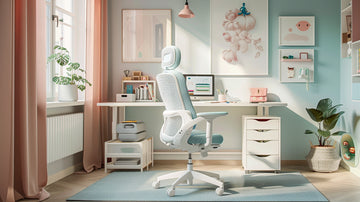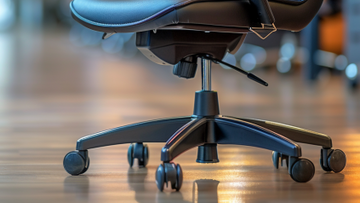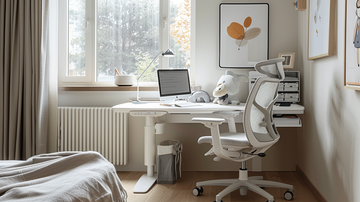Back pain, neck strain, and poor posture - these are just some of the common problems faced by office workers spending hours at a desk each day. An ergonomic chair can help alleviate these issues and promote better health and productivity. But not all chairs are created equal. Over the past several decades, pioneering companies have pushed the evolution of ergonomic chair design. This has led to a range of sophisticated seating solutions that aim to provide customized support and comfort.
In this article, we'll explore the history and major innovations of the oldest and most influential ergonomic chair brands. Understanding the origins and key developments of these industry leaders provides helpful context for evaluating modern ergonomic chairs. We'll see how each company has contributed to advancing ergonomics and comfort in the workplace.
What is an Ergonomic Chair?
An ergonomic chair is designed to support the human body and promote good posture while sitting for extended periods. The key features of an ergonomic chair include:
- Adjustable seat height to ensure feet are flat on the floor
- Adjustable backrest to support the natural curve of the spine
- Adjustable armrests to take pressure off the shoulders and neck
- Tilt mechanism to adjust the angle of the seat
- Cushioned, breathable fabric
- Lumbar support for the lower back
By optimizing the fit and support for an individual user, an ergonomic chair aims to reduce strain on the muscles, joints, and spine. This can help prevent or alleviate pain caused by poor posture and prolonged sitting (source).
The adjustable features allow the user to maintain a comfortable upright or slightly reclined posture, keeping the spine's natural S-shape. This takes pressure off the lower back and can reduce back pain. The armrests and lumbar support also prevent hunching forward.
Overall, a quality ergonomic chair provides customized support and healthy alignment for improved comfort and wellbeing during long workdays.
Herman Miller - The Pioneer
Herman Miller was founded in 1905 in Zeeland, Michigan (1). Originally a manufacturer of traditional wood furniture, the company pivoted to more modern designs in the 1930s under the leadership of designer Gilbert Rohde. However, Herman Miller's focus on ergonomic seating solutions really began in the 1970s.
In 1976, Herman Miller introduced the Ergon Chair, one of the first chairs designed based on ergonomic research and principles (2). This pioneering chair featured adjustable seat height, back angle, and armrests to provide customized support. The Ergon Chair laid the foundation for Herman Miller's later iconic seating designs.
In 1994, Herman Miller released the groundbreaking Aeron Chair, which became an industry standard for ergonomic office chairs (1). Its innovative Pellicle mesh seat and back material provided breathable comfort. Then in 2005, the Embody Chair was introduced, which mimicked the human spine's natural alignment (1). Through these and other designs, Herman Miller cemented its status as a leader in ergonomic seating.
Steelcase
Steelcase was founded in 1912 in Grand Rapids, Michigan as the Metal Office Furniture Company (1). It was started by Peter M. Wege to produce steel office furniture. In 1914, the company began producing metal office furniture and grew to become the largest office furniture manufacturer in the world (2).
Today, Steelcase is known for its ergonomic office chairs. Some of its most popular models include the Leap, Gesture, Think, and Amia chairs. These chairs are designed with adjustable features to provide proper ergonomic support and promote healthy movement while sitting (3).
With over 100 years of experience in office furniture manufacturing, Steelcase has established itself as a leader in ergonomic chair design and innovation.
Sources:
Haworth
Haworth is another major player in the ergonomic chair space. The company was founded in 1948 in Holland, Michigan by G.W. Haworth. Haworth has a strong focus on ergonomic design and research. In 2003, the company released the Zody chair, which was developed in partnership with the Human Performance Institute at the University of Michigan and furniture design experts (https://www.haworth.com/eu/en/knowledge/research/ergonomics.html).
More recently in 2016, Haworth introduced the Fern chair, which features a unique design with dimensional suspension artfully concealed inside the chair to provide comfort and support (https://www.haworth.com/na/en/about/about-haworth/media-room/introducing-fern.html). Haworth remains committed to research and science-based ergonomic design principles in its office chairs.
Humanscale
Humanscale is an American company founded in 1983 in New York that specializes in ergonomic office products, especially chairs. According to the Humanscale website, "Humanscale is the leading designer and manufacturer of ergonomic products that improve the health and comfort of work life."
One of their most iconic products is the Freedom chair, introduced in 1999. Designed by renowned ergonomics designer Niels Diffrient, the Freedom chair was a breakthrough in ergonomic seating with its weight-sensitive recline and self-adjusting recline mechanism. As described on the company overview page, "Humanscale solidified its status as a true market leader with the introduction of the Freedom chair in 1999."
The history of ergonomic chairs goes back even further, to the 1970s introduction of the Ergon chair designed by Bill Stumpf. As explained in this Humanscale article, "the ergonomic office chair landed in your living room," evolving from early office models to more stylish, adaptable versions for home use.
Knoll
Knoll was founded in 1938 in Pennsylvania by Hans Knoll. According to Our Timeline and History | Knoll, Hans Knoll started the company after working for 3 years in the furniture industry in Europe. He wanted to bring modern design to America. In 1946, he married Florence Schust and she joined him at Knoll, bringing her own design talents. Together they recruited famous designers like Eero Saarinen, Harry Bertoia and Ludwig Mies van der Rohe.
One of Knoll's most iconic chairs is the Generation chair which was released in 1996. According to The Chair That Changed it All, the Generation chair was designed to be the first task chair that provided tailored lumbar support. It used elastomeric materials that provided support and flexibility. The Generation chair set a new standard for task seating and ergonomic design.
Herman Miller vs. Competitors
Herman Miller has been a pioneer in the ergonomic chair industry since it released the Aeron chair in 1994. This innovative chair featured a breathable mesh material and adjustable components to provide customized support. The Aeron became an iconic and influential office chair design that prompted other manufacturers to improve their ergonomic offerings.
While Herman Miller was an early innovator, competitors like Steelcase, Haworth, and Humanscale have since caught up in many respects. For example, Steelcase's Leap chair offers similar adjustability and customization as the Aeron. And Haworth's Zody chair was the first to receive endorsement from the American Physical Therapy Association.
However, Herman Miller still leads the market in terms of brand recognition, sales, and industry awards. According to Grand View Research, Herman Miller held a 24.7% share of the global ergonomic chair market in 2021. The company has also won over 100 design awards for its chairs. This success stems from Herman Miller's continued focus on research, user testing, and implementing the latest technologies in its ergonomic seating.
Herman Miller also offers more options and customizability than competitors. The Aeron chair alone comes in three sizes and multiple color and material choices. In contrast, Steelcase and Haworth have more limited selections. Additionally, Herman Miller's online configurators make it easy for customers to tailor chairs to their needs.
While Herman Miller faces tough competition, its legacy of innovation and stellar brand reputation have allowed it to remain a leader in the ergonomic chair industry.
Latest Innovations
Ergonomic chair brands continue to innovate and introduce new features and technologies to improve comfort, adjustability, and health benefits. Some of the latest innovations include:
New Materials: Many brands are using new types of mesh, padding, and fabrics aimed at increasing breathability and comfort. For example, Steelcase introduced 3D knit back material that molds to the user's shape. Herman Miller uses a pixelated support system in its Cosm chair.
Enhanced Adjustability: Chairs now allow more customization of the backrest, armrests, seat depth, recline tension, etc. Gesture is a chair by Steelcase with armrests that sense and respond to the user's movements. The Herman Miller Cosm has Auto-Harmonic Tilt to match the user's movements.
Intelligent Features: Some chairs incorporate smart technology and sensors. For example, the Haworth Fern chair has a lumbar support that automatically adjusts based on the user's posture and position. The Humanscale Diffrient Smart Chair uses a tri-panel backrest that mimics the movement of the spine.
Health Focus: New chairs target physical health with movement encouragement, improved circulation, and alignment. Knoll's Toboggan chair prompts the sitter to move and change postures. The Herman Miller Embody chair was designed with focus on enhancing blood and oxygen flow.
By continually enhancing ergonomics and incorporating the latest technology, brands strive to create the healthiest and most comfortable chairs possible.
Conclusion
In summary, Herman Miller pioneered the ergonomic chair market starting in the 1960s. They introduced innovative designs like the Aeron chair that became wildly popular in office environments. While competitors like Steelcase, Haworth, Humanscale, and Knoll have entered the market, Herman Miller continues to lead with cutting edge ergonomic research and chair technology.
Ergonomic chairs have come a long way since the early designs, with continuous improvements in adjustability, materials, and support. As our understanding of ergonomics and workplace health advances, companies will continue innovating to create chairs that promote proper posture, comfort, and productivity. Herman Miller set the standard for the industry, and their iconic chairs remain go-to options for exceptional back support during long work days.





